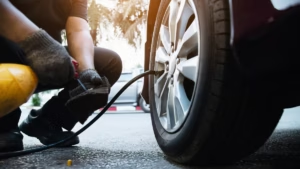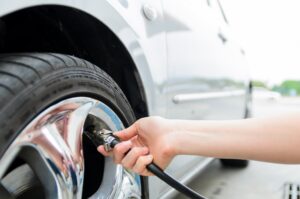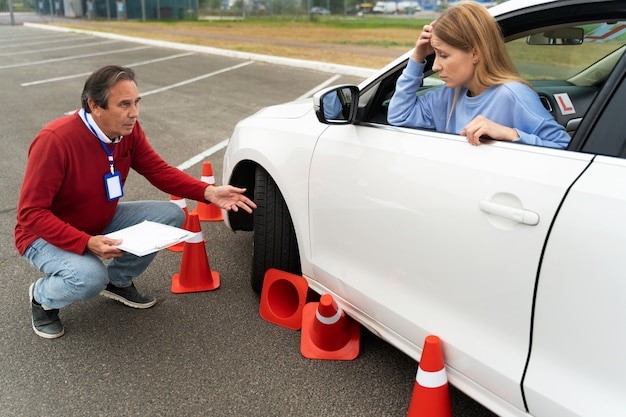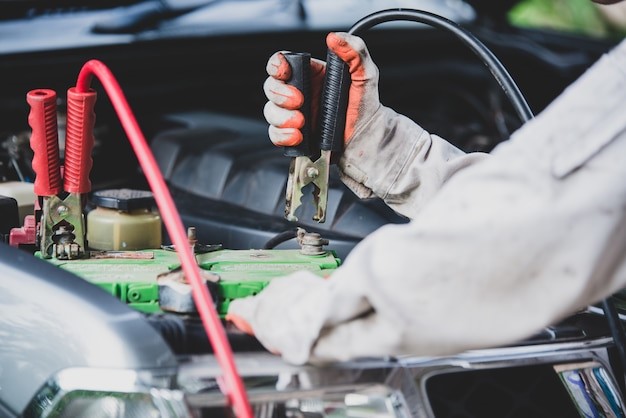Ever noticed your car feels a bit off while driving? It might be time to put air in the tires. But how do I put air in my tires? Don’t worry, it may sound difficult, but you can do it even without any expertise.
It is super important to keep the right amount of air in your tires. Because too little or too much air can make your car harder to handle. It may wear out your tires faster or even lead to a blowout. Moreover, it reduces your car’s fuel use. Read this guide to learn how to inflate car tires. Let’s get started!
How To Check Tire Pressure
Maintaining your tires with the correct tire pressure is also one of the easiest, yet crucial things to do to keep your vehicle safe, efficient, and perform well. Most drivers ignore the maintenance of tires, though they should know the fact that underinflated or overinflated tires may lead to serious consequences. Having too low pressure in tires will make your vehicle difficult to control, longer distances to stop and exert a higher pressure on the tires and having the tires having too much air will cause lack of traction and uneasy rides. Keeping up with the tire pressure allows avoiding such problems and enables the tires to have a much longer life.
Why Checking Tire Pressure Matters
- Safe Handling: Your car will be more responsive to steering and the brakes in the case of tires that are well filled.
- Fuel Efficiency: Tires of the appropriate pressure deteriorate the rolling resistance leading to your car consuming less fuel.
- Even Tire Wear: Correct pressure eliminates the possibility of uneven wear, making your tires last longer.
- Blowout Prevention: By maintaining recommended PSI the likelihood of the vehicle going on-road with tire puncture also becomes minimum.
How Much Air Should I Put in My Tires?
Never put more pressure on tires than recommended by the manufacturer (PSI) which is listed in your car manual or is on a sticker on the driver side door. Be cautious of the overinflation or the underinflation as it may lead to safety, fuel economy, and tire wear. Inspect all tires (including spares) and check them when cold to be sure of the correct measurements.
How Do I Put Air in My Tires? Step-by-Step Guide

Maintaining the right air pressure in your tires is important for your and your vehicle’s safety. What if your tires are running low on air during a drive? Following is a step by step guide to help you inflate your tires right on the road.
Step 1: Gather the Necessary Tools for Tire Inflation
First of all, you must have all the necessary tools with you, including a pressure gauge and an air compressor. Moreover, it is also beneficial to keep a small gauge in your box for quick checks anytime.
Step 2: Check the Recommended Tire Pressure for Your Vehicle
Check your vehicle manual to find the right PSI (pounds per square inch) for your tires. You can look at the sticker on the driver’s side door to analyze it. However, it’s important to follow the recommended pressure.
Step 3: How to Use a Tire Pressure Gauge
Do you know how to use a tire pressure gauge? If not, then let’s get started.
- Remove the cap from your tire’s valve stem.
- Place the gauge onto the stem and press firmly.
- It will show you the current pressure with a hissing sound.
- Your car needs more air if the number is lower than what your car recommends.
Step 4: Inflating Your Tires with an Air Compressor
Most gas stations have air compressors you can use.
- Attach the air hose to the valve stem.
- Press it in tightly until you hear air flowing.
- Add air for a few seconds at a time.
- Check the pressure again with your gauge.
Keep going until you reach the right PSI. If you add too much, release a little air by pressing the valve gently.
Step 5: How to Safely Remove and Replace Valve Stem Caps
At last, when you’re done. Take off the air hose and put the valve stem cap back on. It helps keep dirt and moisture out of the valve. It is a very important step. Don’t overlook it as a small step.
Common Mistakes to Avoid When Inflating Tires

Taking care of your tires is essential for safe driving. You have to take care of little errors to avoid serious injuries. There are some common mistakes that people make when inflating their tires.
Not Checking Tire Pressure Before Adding Air
It is a key point to check the current tire pressure first before adding air. Some people wait until the tire looks low. It is necessary to know if you need to add more air or not. However, it’s not a good decision because tires can be underinflated or overinflated and still look fine.
Ignoring the Recommended PSI
One of the biggest mistakes is to overlook PSI (pounds per square inch). Every car has a specific tire pressure that works best for it. You can usually find it on a sticker inside the driver’s door or in the owner’s manual. Ignoring this number can disturb your drive. It can cause your tires to wear out faster, hurt your fuel economy, or even lead to unsafe driving conditions.
Overinflating the Tires
Many people take it easy to overinflating the tires thinking of better performance. However, Overinflated tires can cause your ride rougher and tire become too stiff when it touches the road. This can increase the chance of a blowout and can lead to poor grip, especially in wet conditions. We prefer you to always add air little by little and recheck with the gauge to avoid going over the recommended PSI.
Checking Pressure When Tires Are Warm
You can check your tire pressure right after driving. The air inside your tire heats up and increases the pressure after driving. Never check the reading after driving; you will get the accurate reading right after the tires have cooled down. You can check it before you start it or after staying for a few hours.
Forgetting to Check the Spare Tire
Many people overlook their spare tire because it’s out of sight. But a flat spare won’t help you in an emergency. Make it an important part of your routine to check your spare tire’s pressure every few months. That it’s ready to go if you ever need it.
Despite all, if you ever find yourself stuck on the road, need a hand on the road, get us for quick and reliable roadside assistance whenever you need it.
CTA
Stuck with low or uneven tire pressure? Contact All 4 One Transportation Services for fast, professional help anytime!
Final Thoughts
Tires may seem a small part of your vehicle. But it plays a big role in keeping your car safe and running smoothly. You can do it within a few minutes and save your fuel consumption and secure yourself. For this purpose, keep checking regularly, follow the recommended PSI, and don’t forget the spire too.
FAQ’s
Do this by making it a point to check your tire pressure monthly and prior to any long journeys in order to ensure safety and best performance.
Never rely on the accuracy of the tire pressure as it should always be verified using a quality digital or analog tire pressure gauge. Have nothing to do with guesswork or faulty gauges.
Bleed a bit of air and recheck with a gauge till pressure corresponds to the manufacturer recommended PSI.
Tires are cold before driving, or a few hours after parking gives an immediate reading.




